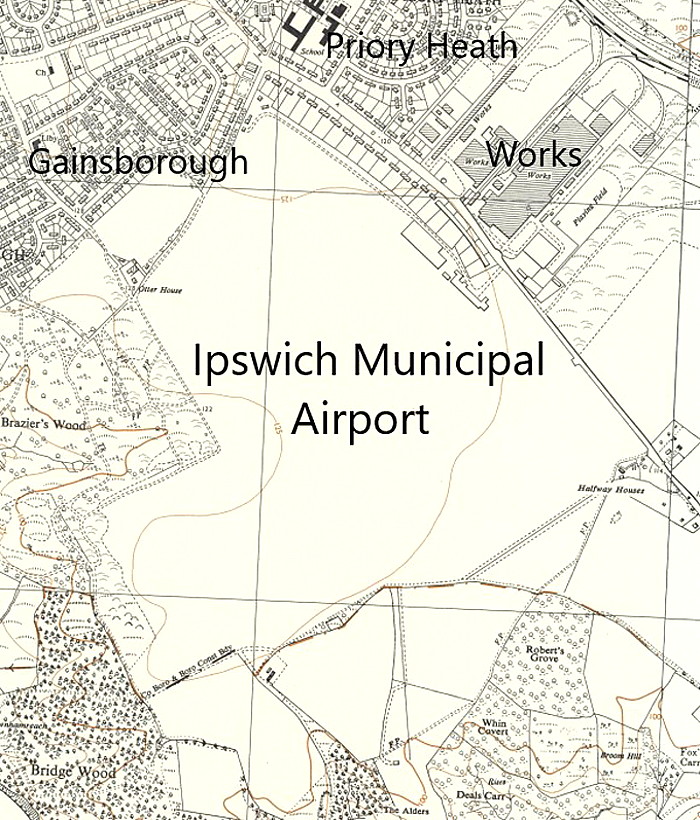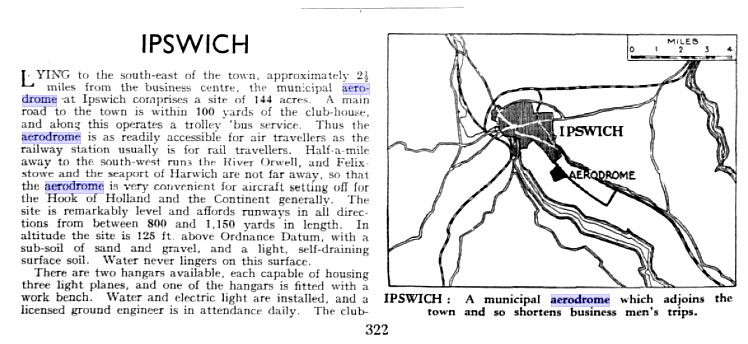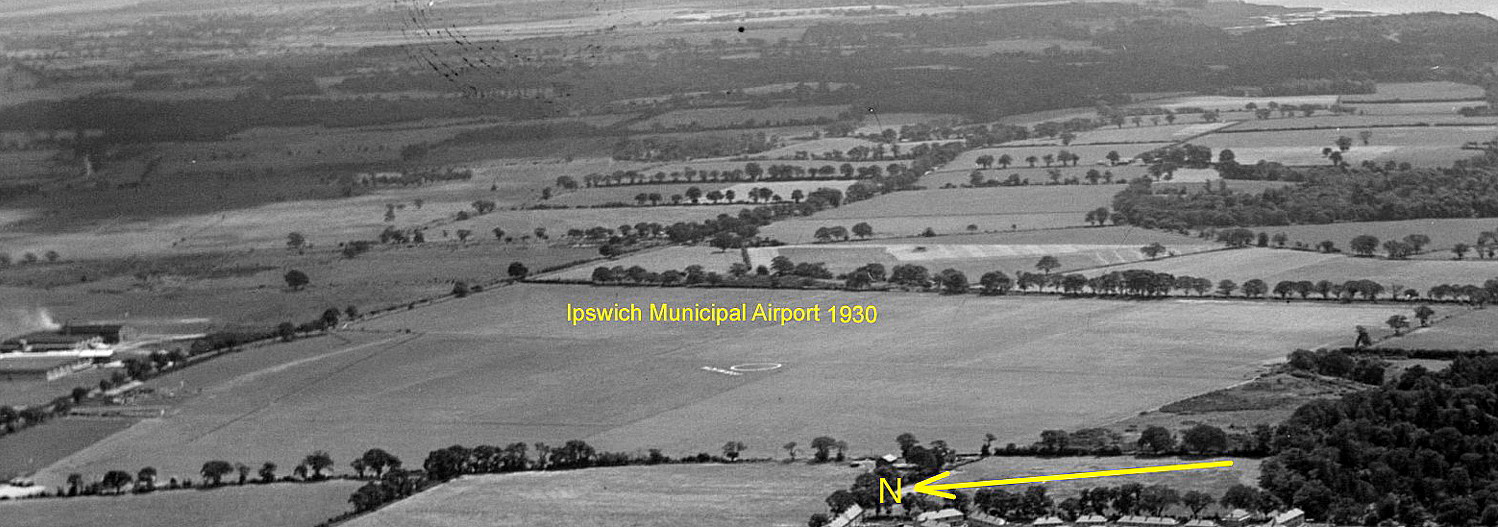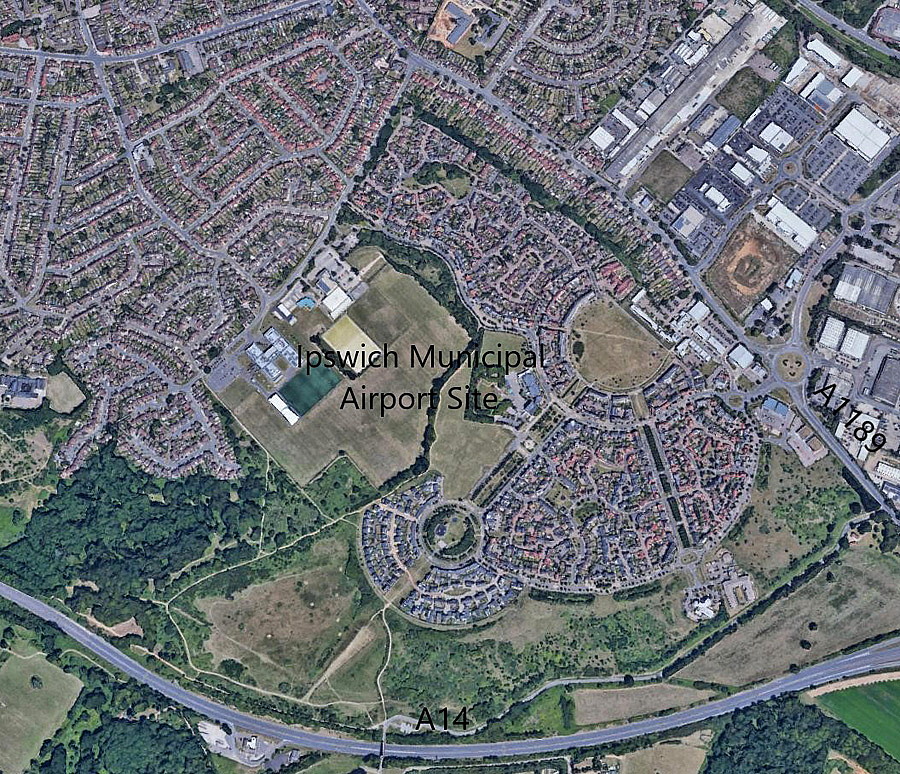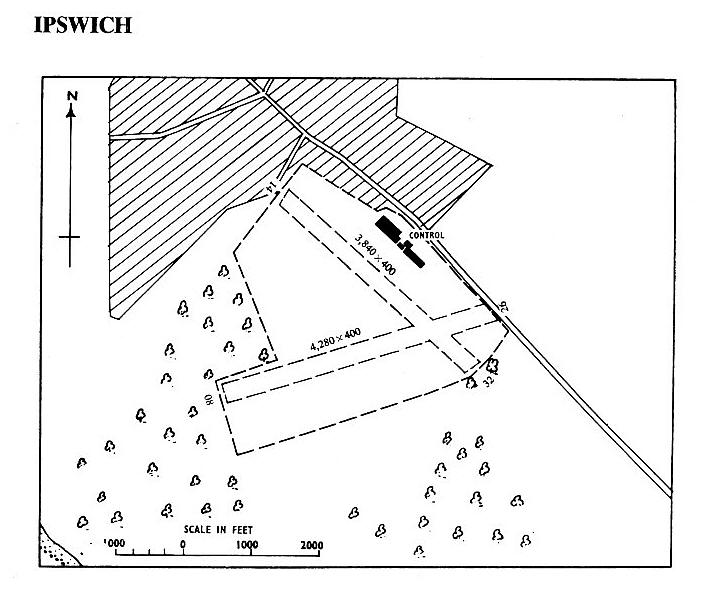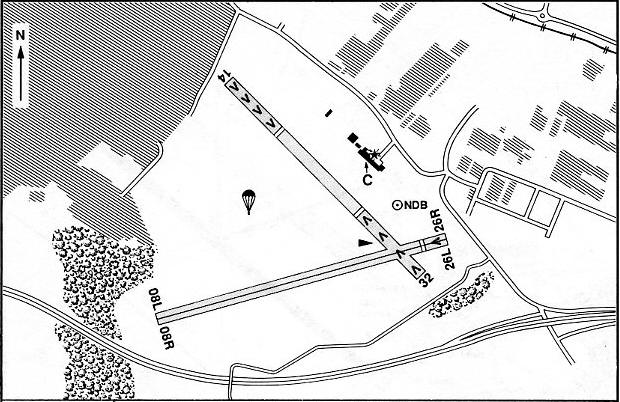Ipswich
NOTE: The map simply shows the location of Ipswich within the UK.
IPSWICH see also GIPPESWYK HALL FARM
IPSWICH see also PRIORY HEATH
IPSWICH: Temporary aerodrome(s)?
NOTES: Venue for CD Barnards Air Tours in June 1931. The same goes for the 1933 No.1 Tour of the Sir Alan Cobham enterprise who performed at Ipswich on the 27th May. Does anybody now know where they actually operated from? I appreciate it’s obvious to assume they both used IPSWICH airport but experience has shown that very often these “Flying Circus” operators preferred separate sites they could have total control over for their highly intensive activities.
On the 22nd June 1935 it appears that the Cobham Tour visited Ipswich again but I’d like to know the reason for their apparently chaotic zig-zagging from venue to venue during this period. For example on the 19th June they displayed in Henly-on-Thames and on the 20th Cambridge. On the 21st Chesham was scheduled and of course, Ipswich on the 22nd with Romford on the 23rd and Havant on the 24th.
The reason I am reluctant to assume that IPSWICH aerodrome was used is simply because that quite often they selected fields, sometimes quite close to existing aerodromes, to both save costs but also to have full control of the proceedings. If anybody can kindly offer advice, this will be most welcome.
IPSWICH: Municipal aerodrome later military airfield, then regional airport and subsequently civil aerodrome
The first picture (map) is via the author.
A MICHAEL T HOLDER GALLERY
Note: The two part article above, divided into two to make it easier to read, was published in Flight magazine on the 15th April 1932.
Note: The last item, the area view, was added from my Google Earth © derived database.
Military users: WW2: RAF Fighter Command 70 (Training) Group
679 Sqdn (Hurricanes/Martinets/ Vengeance TTs) AA Co-operation Unit
A QUESTION
It is reported that Sir Alan Cobham visited Ipswich during his 1929 Municipal Aerodrome Campaign, on the 2nd October. So far no evidence has been found of where he landed. This airport seems the most likely location? It was very common in those days for an aerodrome to be used for several months before having an official opening ceremony.
Operated by: 1930: Suffolk and Eastern Counties Aeroplane Club, but only for a year or two some claim.
1n 1933 another expert reckons it was the Suffolk Aeroplane Club who operated the airport on behalf of Ipswich Town Council. It appears the ‘depression’ of the 1930s put paid to these two clubs, (operating from this site that is), so what happened then? Did the Council take it over?
1954: East Anglian Flying Services
1965 to 1970 (at least?) Channel Airways
1980s: Ipswich Airport Ltd
1990 to 1997: Ipswich Borough Council
British airline users: Pre 1940: Crilly Airways, Southern Airways
Post 1945: Channel Airways, East Anglian Flying Services
Car ferry: Post 1945: Channel Airways
Flying club/schools: Pre 1940: Eastern Counties Aeroplane Club, Suffolk and Eastern Counties Aeroplane Club, Suffolk Aeroplane Club*
Post 1945: East Anglian Flying Club, East Anglian School of Flying, Horizon Flying Club
1959 ‘snapshot’. East Anglian Flying Club
Location: Nacton Road, SE of Gainsborough, SE boundary of Ipswich in WW2
Period of operation: 1929, (some say 1930). One account states work started in 1930. (After the decision to create a Municipal Aerodrome was taken in 1929?) That would explain the discrepancy in dates?
Military: WW2+? Appears to have closed soon after WW2?
Reopened in 1954 by East Anglian Flying Services. Closed for good in 1998/9?
Note: These maps are reproduced with the kind permission of Pooleys Flight Equipment Ltd. Copyright Robert Pooley 2014.
Runways: Initially 147 acres, ‘all-over’ grass? Max landing run 1933: 960 grass
WW2: NE/SW 1143 grass NW/SE 1143 grass
1965: 08/26 1304x122 grass 14/32 1170x122 grass
1990: 08/26 1125x45 grass 14/32 1030x45 grass
1997: 08/26 1125x22 grass 14/32 1030x45 grass
NOTES: Anderson & Pool Aviation Co operated from IPSWICH (possibly from this site?) in the early 1920s but what exactly did they do, and where did they do it? Does anybody now know?
*SUFFOLK AEROPLANE CLUB
It is quite possible that these three titles all refer to essentially the same club for a variety of reasons. Mainly it seems, in those days, was the lack of sound finances but an abundance of enthusiasm. Are their histories known? Another cause was sloppy reporting, always a peril in any research, and even members of aero clubs like to shorten the full name.
FLYING CIRCUS VENUE
Venue, (25th July 1932), for Alan Cobham’s National Aviation Day UK Display Tour.
EAST ANGLIAN FLYING SERVICES
In his book, (one of a triology), More Tails Of The Fifties, Peter Campbell tells us that East Anglian Flying Services operated, (except in the winter), regular scheduled services between IPSWICH, ROCHESTER, SOUTHEND, SHOREHAM, PORTSMOUTH, Paris (Le Bourget), JERSEY and GUERNSEY.
Initially they used de Havilland DH89A Dragon Rapides; G-AEMH, G-AKJZ, G-AKRN and G-AKSC. By 1955 they were introducing de Havilland DH104 Doves which were of course then - super modern, state-of-the art regional airliners. These being, G-ANVU, G-AOBZ and G-AOCE.
THE EAST ANGLIAN FLYING CLUB
The East Anglian Flying Club are notable for operating, (in the late 1960s), apart from their Auster 5 & J/1N types – a SIAI-Marchetti SM205.
A PERSONAL MEMORY
On the 20th March 1993, my good friend Guy Browning and I decided, on a last minute whim in the afternoon, to fly to IPSWICH from TOP FARM. Perhaps we'd heard rumours that it was under threat of closure, so wanted to get it in our logbooks. We flew in with the Piper PA-28-181 Cherokee Archer II, G-BEXW, (previously N38122 in the USA). In those days I had an obsession to take a picture or three of everywhere I flew from or into. But can I find one of G-BEXW here? No, nothing, zilch, not a trace
But, who knows? Perhaps somebody else did?
Ed Fowler
This comment was written on: 2018-02-19 17:05:39Ipswich Aero Club 1935 Tom’s love of flying literally took off at the age of 21 years, when he joined Ipswich Aero Club. ‘I was dreadfully keen in those days’ (1935), Tom recalled. But his progress was severely curtailed by the cost 25/- (£1.25) per flying hour! This sounds ludicrous, but not when you are only earning about £12/10/0 (£12.50) a week! ‘They had incredible Aeroplanes’, Tom added. 'We had things like a Miles Whitney Straight, The MII Whitney Straight was designed by Fredrick & George Miles of Philips & Powis (Miles Aircraft) 15th May 1936 as the result of collaboration with Whitney Straight, a Grand Prix Motor Racing Driver, Aviator and Businessman. It was a low-wing monoplane, with fixed main undercarriage in aerodynamic fairings plus a fixed Tailwheel. Construction was mainly of wood, with spruce frames and 3-ply birch covering, and the Wings had vacuum-operated split Flaps. It was initially powered by a 130 hp (97 kW) de Havilland Gipsy Major I piston engine. Tom explained that the Miles Whitney Straight was a low-wing Monoplane, with side by side seating and dual controls. We had a Czechoslovakian machine called a Hillson Praga.' The Praga was produced before WW2 both by ČKD-Praga in Prague and, under licence as the Hillson Praga, by F Hills & Sons Ltd of Manchester in the UK. Approximately 150 No. E.114B models were built, including roughly 40 of the Hillson Variant. The Hillson Praga 'had got quite a big high monoplane, and 2 seats, side-by-side, and it had got a throttle, which was a long rod with a knob on, which you pressed in like this.' A search reveals that it is not unlike the Auster Autocrat. The Miles Magister, (the Maggie) which followed shortly afterwards, was similar, both being powered by a Gipsy Major I engine, but the Magister had Tandem Seating. Civil Air Guard July 1938 ‘Then came the Civil Air Guard‘, Tom recalled. ‘I became aware of it, and I joined it because they ran lessons in Ipswich. You could learn all about Radio, and practise sending and receiving Morse, and practise Navigation, and things like this.’ He remembered building up his flying hours by sharing the flying (and cost) with a fellow member, usually by means of long Cross-countries, such as flying down to Exeter for lunch, then to Redhill Airport for tea, and returning to Ipswich in the evening. RAF Volunteer Reserve Ipswich 1939 Just less than 2 years after it formed in July 1936, the RAF Volunteer Reserve came to Ipswich. This was what Tom had been waiting for. Tom enlisted on 12th June 1939 as an AC2 and was promoted to Sergeant the next day aged 25 years. The RAFVR had a similar object to the Civil Air Guard – to provide a Reserve of Aircrew in the event of War. As Aircrew had already signed on the dotted line, it became the Principal means of Recruitment in the RAF on 3rd September 1939. Tom recalls: 'Then they opened an RAF Reserve Station at Ipswich, on the Aerodrome. A big new building - there was lovely parquet flooring and everything in it, even a Link Trainer. This was a 1st Class thing...and, of course, a lot of people tried to get in, I was one of the lucky ones that, say, passed into that... About 17 got in out of about 311 and some of them never went Solo. So they either went out, or went on to be Navigators, or WOp/AGs or something. Then, I always think about 3 days before the War, they said, right, you're in! Now we want the Aircraft moved. We're moving Aircraft from the East Coast to the West Coast because the naughty Germans might come and pinch them, or something. So I remember taking these and flying to RAF Filton north of Bristol (the Airfield was attacked on 25 September 1940) and to RAF Weston-super-Mare (by 1938, a passenger terminal and administration building had been completed, along with a side opening hangar) - and places like that. Around London, they'd got these Barrage Balloons - a most incredible sight.
Reply from Dick Flute:
Hi Ed, Many thanks for your contribution. I shall certainly keep this posted. Best regards, Dick
We'd love to hear from you, so please scroll down to leave a comment!
Leave a comment ...
Copyright (c) UK Airfield Guide















